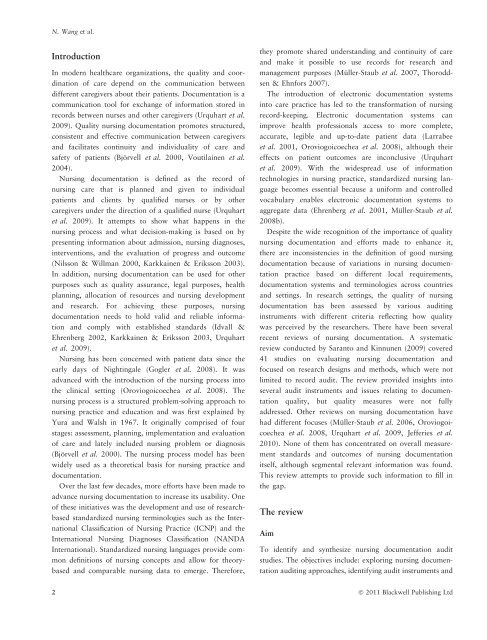Quality of nursing documentation and approaches to its evaluation ...
Quality of nursing documentation and approaches to its evaluation ...
Quality of nursing documentation and approaches to its evaluation ...
You also want an ePaper? Increase the reach of your titles
YUMPU automatically turns print PDFs into web optimized ePapers that Google loves.
N. Wang et al.<br />
Introduction<br />
In modern healthcare organizations, the quality <strong>and</strong> coordination<br />
<strong>of</strong> care depend on the communication between<br />
different caregivers about their patients. Documentation is a<br />
communication <strong>to</strong>ol for exchange <strong>of</strong> information s<strong>to</strong>red in<br />
records between nurses <strong>and</strong> other caregivers (Urquhart et al.<br />
2009). <strong>Quality</strong> <strong>nursing</strong> <strong>documentation</strong> promotes structured,<br />
consistent <strong>and</strong> effective communication between caregivers<br />
<strong>and</strong> facilitates continuity <strong>and</strong> individuality <strong>of</strong> care <strong>and</strong><br />
safety <strong>of</strong> patients (Björvell et al. 2000, Voutilainen et al.<br />
2004).<br />
Nursing <strong>documentation</strong> is defined as the record <strong>of</strong><br />
<strong>nursing</strong> care that is planned <strong>and</strong> given <strong>to</strong> individual<br />
patients <strong>and</strong> clients by qualified nurses or by other<br />
caregivers under the direction <strong>of</strong> a qualified nurse (Urquhart<br />
et al. 2009). It attempts <strong>to</strong> show what happens in the<br />
<strong>nursing</strong> process <strong>and</strong> what decision-making is based on by<br />
presenting information about admission, <strong>nursing</strong> diagnoses,<br />
interventions, <strong>and</strong> the <strong>evaluation</strong> <strong>of</strong> progress <strong>and</strong> outcome<br />
(Nilsson & Willman 2000, Karkkainen & Eriksson 2003).<br />
In addition, <strong>nursing</strong> <strong>documentation</strong> can be used for other<br />
purposes such as quality assurance, legal purposes, health<br />
planning, allocation <strong>of</strong> resources <strong>and</strong> <strong>nursing</strong> development<br />
<strong>and</strong> research. For achieving these purposes, <strong>nursing</strong><br />
<strong>documentation</strong> needs <strong>to</strong> hold valid <strong>and</strong> reliable information<br />
<strong>and</strong> comply with established st<strong>and</strong>ards (Idvall &<br />
Ehrenberg 2002, Karkkainen & Eriksson 2003, Urquhart<br />
et al. 2009).<br />
Nursing has been concerned with patient data since the<br />
early days <strong>of</strong> Nightingale (Gogler et al. 2008). It was<br />
advanced with the introduction <strong>of</strong> the <strong>nursing</strong> process in<strong>to</strong><br />
the clinical setting (Oroviogoicoechea et al. 2008). The<br />
<strong>nursing</strong> process is a structured problem-solving approach <strong>to</strong><br />
<strong>nursing</strong> practice <strong>and</strong> education <strong>and</strong> was first explained by<br />
Yura <strong>and</strong> Walsh in 1967. It originally comprised <strong>of</strong> four<br />
stages: assessment, planning, implementation <strong>and</strong> <strong>evaluation</strong><br />
<strong>of</strong> care <strong>and</strong> lately included <strong>nursing</strong> problem or diagnosis<br />
(Björvell et al. 2000). The <strong>nursing</strong> process model has been<br />
widely used as a theoretical basis for <strong>nursing</strong> practice <strong>and</strong><br />
<strong>documentation</strong>.<br />
Over the last few decades, more efforts have been made <strong>to</strong><br />
advance <strong>nursing</strong> <strong>documentation</strong> <strong>to</strong> increase <strong>its</strong> usability. One<br />
<strong>of</strong> these initiatives was the development <strong>and</strong> use <strong>of</strong> researchbased<br />
st<strong>and</strong>ardized <strong>nursing</strong> terminologies such as the International<br />
Classification <strong>of</strong> Nursing Practice (ICNP) <strong>and</strong> the<br />
International Nursing Diagnoses Classification (NANDA<br />
International). St<strong>and</strong>ardized <strong>nursing</strong> languages provide common<br />
definitions <strong>of</strong> <strong>nursing</strong> concepts <strong>and</strong> allow for theorybased<br />
<strong>and</strong> comparable <strong>nursing</strong> data <strong>to</strong> emerge. Therefore,<br />
they promote shared underst<strong>and</strong>ing <strong>and</strong> continuity <strong>of</strong> care<br />
<strong>and</strong> make it possible <strong>to</strong> use records for research <strong>and</strong><br />
management purposes (Müller-Staub et al. 2007, Thoroddsen<br />
& Ehnfors 2007).<br />
The introduction <strong>of</strong> electronic <strong>documentation</strong> systems<br />
in<strong>to</strong> care practice has led <strong>to</strong> the transformation <strong>of</strong> <strong>nursing</strong><br />
record-keeping. Electronic <strong>documentation</strong> systems can<br />
improve health pr<strong>of</strong>essionals access <strong>to</strong> more complete,<br />
accurate, legible <strong>and</strong> up-<strong>to</strong>-date patient data (Larrabee<br />
et al. 2001, Oroviogoicoechea et al. 2008), although their<br />
effects on patient outcomes are inconclusive (Urquhart<br />
et al. 2009). With the widespread use <strong>of</strong> information<br />
technologies in <strong>nursing</strong> practice, st<strong>and</strong>ardized <strong>nursing</strong> language<br />
becomes essential because a uniform <strong>and</strong> controlled<br />
vocabulary enables electronic <strong>documentation</strong> systems <strong>to</strong><br />
aggregate data (Ehrenberg et al. 2001, Müller-Staub et al.<br />
2008b).<br />
Despite the wide recognition <strong>of</strong> the importance <strong>of</strong> quality<br />
<strong>nursing</strong> <strong>documentation</strong> <strong>and</strong> efforts made <strong>to</strong> enhance it,<br />
there are inconsistencies in the definition <strong>of</strong> good <strong>nursing</strong><br />
<strong>documentation</strong> because <strong>of</strong> variations in <strong>nursing</strong> <strong>documentation</strong><br />
practice based on different local requirements,<br />
<strong>documentation</strong> systems <strong>and</strong> terminologies across countries<br />
<strong>and</strong> settings. In research settings, the quality <strong>of</strong> <strong>nursing</strong><br />
<strong>documentation</strong> has been assessed by various auditing<br />
instruments with different criteria reflecting how quality<br />
was perceived by the researchers. There have been several<br />
recent reviews <strong>of</strong> <strong>nursing</strong> <strong>documentation</strong>. A systematic<br />
review conducted by Saran<strong>to</strong> <strong>and</strong> Kinnunen (2009) covered<br />
41 studies on evaluating <strong>nursing</strong> <strong>documentation</strong> <strong>and</strong><br />
focused on research designs <strong>and</strong> methods, which were not<br />
limited <strong>to</strong> record audit. The review provided insights in<strong>to</strong><br />
several audit instruments <strong>and</strong> issues relating <strong>to</strong> <strong>documentation</strong><br />
quality, but quality measures were not fully<br />
addressed. Other reviews on <strong>nursing</strong> <strong>documentation</strong> have<br />
had different focuses (Müller-Staub et al. 2006, Oroviogoicoechea<br />
et al. 2008, Urquhart et al. 2009, Jefferies et al.<br />
2010). None <strong>of</strong> them has concentrated on overall measurement<br />
st<strong>and</strong>ards <strong>and</strong> outcomes <strong>of</strong> <strong>nursing</strong> <strong>documentation</strong><br />
<strong>its</strong>elf, although segmental relevant information was found.<br />
This review attempts <strong>to</strong> provide such information <strong>to</strong> fill in<br />
the gap.<br />
The review<br />
Aim<br />
To identify <strong>and</strong> synthesize <strong>nursing</strong> <strong>documentation</strong> audit<br />
studies. The objectives include: exploring <strong>nursing</strong> <strong>documentation</strong><br />
auditing <strong>approaches</strong>, identifying audit instruments <strong>and</strong><br />
2 Ó 2011 Blackwell Publishing Ltd

















